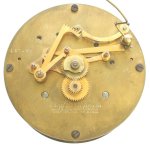 |
The Chelsea Clock Company is probably the last clock manufacturer in the United States. Their factory in Boston, MA, has been offering high-grade mechanical clocks since 1897. The company was originally founded as the Eastman Clock Company in 1886. The name changed to the Boston Clock Company in 1893. The United States Navy supplied their ships with Chelsea clocks that are now in strong demand among collectors. Earlier Chelseas, like the one on this page, were equipped with seven-jewel escapements provided by Waltham. This clock, from about 1920, has nine jewels because two more were added later. Figure 1 shows the front of the movement with the escapement.
 |
Fig. 1
The back side of the movement is shown in figure 2. The ship's bell strike parts work similarly compared to the Schatz ship's bell clock in this website, though the design is different.
 |
Fig. 2
The time and strike trains are arranged in two layers. The relationship between the gears in the strike train must be adjusted such that the striking stops just after the second drop of the hammer, and the warning wheel rotates by about a quarter turn when the clock goes into warning. This is the most difficult part of assembling the clock.
 |
Fig. 3
The centershaft (the third wheel of the time train) consists of two parts, one of which must be placed between the plates during assembly of the strike train, as shown in Figure 4.
 |
Fig. 4
Figure 5 shows the time train. All brass gears in this clock are gold-plated. The pinion leaves are polished to a mirror finish. The quality and craftsmanship in vintage Chelseas are superb.
 |
Fig. 5
| 1897 1899 1904 1909 1914 1919 1924 1929 1934 1939 1944 1949 1954 1959 1964 1969 1974 1979 1984 1989 |
001 3937 16459 59641 97528 136237 159719 194237 213894 256235 472765 559240 598659 638906 673459 743137 786288 827760 857063 868171 |
Japy French Clock
Clock Repair Main Page
Escapements in Motion
Links Page
Tributes Page